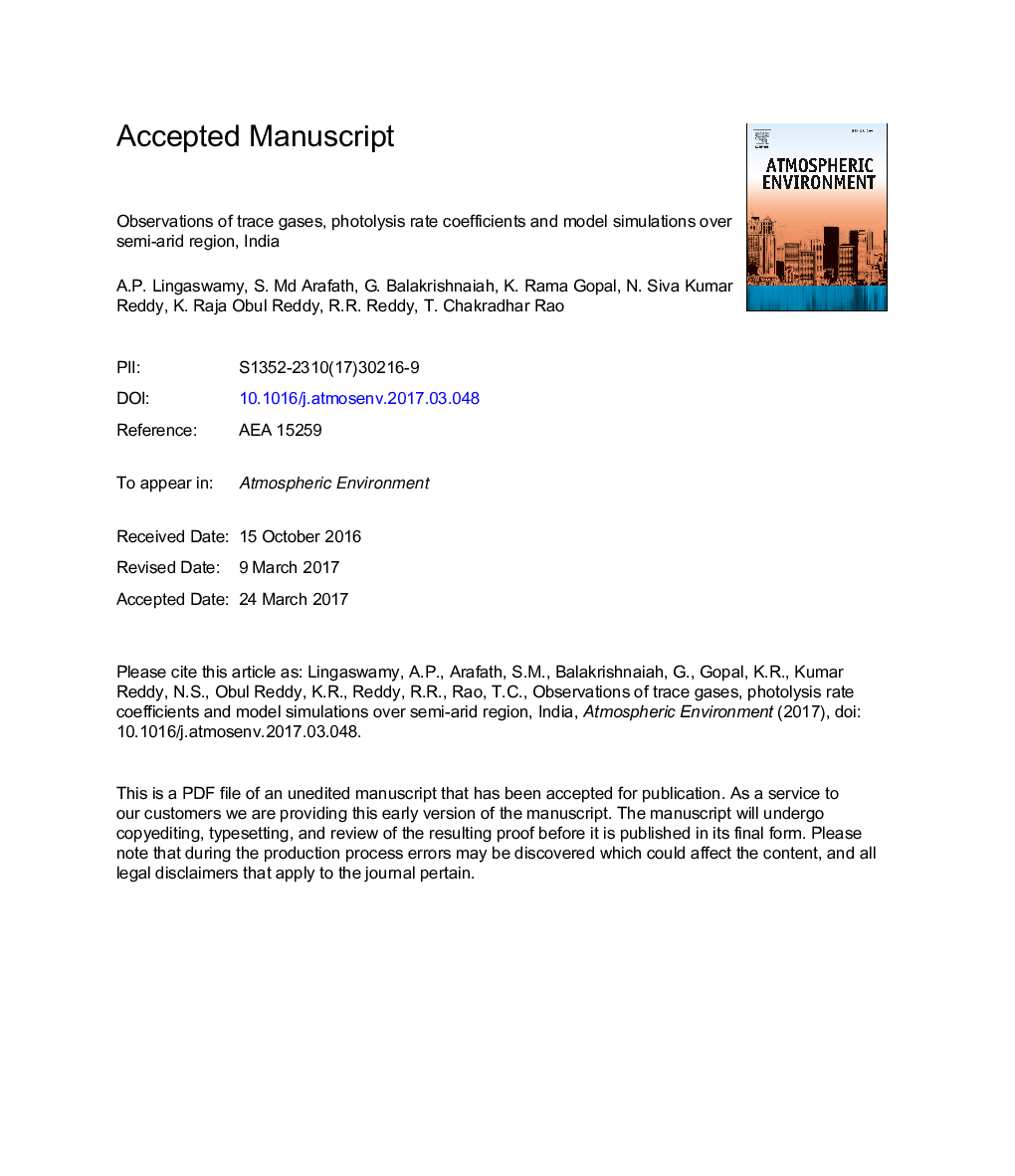| کد مقاله | کد نشریه | سال انتشار | مقاله انگلیسی | نسخه تمام متن |
|---|---|---|---|---|
| 5753315 | 1620316 | 2017 | 43 صفحه PDF | دانلود رایگان |
عنوان انگلیسی مقاله ISI
Observations of trace gases, photolysis rate coefficients and model simulations over semi-arid region, India
ترجمه فارسی عنوان
مشاهدات گازهای ردیابی، ضریب سرعت فوتولیز و شبیه سازی مدل در منطقه نیمه خشک هند
دانلود مقاله + سفارش ترجمه
دانلود مقاله ISI انگلیسی
رایگان برای ایرانیان
کلمات کلیدی
ردیابی گازها، تقریبی منبع، دید، ضرایب فوتولیز، مدل انتقال تابشی،
موضوعات مرتبط
مهندسی و علوم پایه
علوم زمین و سیارات
علم هواشناسی
چکیده انگلیسی
Continuous ground-based measurements of CO, SO2 and NO2 were carried out in a semi-arid rural area, Anantapur [14.62 0N, 77.65 0E], Southern India, for the period January 2012-December 2012. The maximum CO concentration was observed in winter (310 ± 17 ppbv) followed by summer (180 ± 21 ppbv) and post monsoon (174 ± 20 ppbv), while the minimum in monsoon (72 ± 9 ppbv). Seasonal mean NO2/NOx ratios for monsoon, post monsoon, winter and summer were about 0.88, 0.91, 0.76 and 0.80 respectively, indicating a higher conversion of NO to NO2 over the measurement site. Monthly mean low SO2 mixing ratio was found (0.46 ± 0.02 ppbv) in monsoon and high (2.42 ± 0.21 ppbv) in winter. Keeping the emissions aside, the levels of CO, SO2 and NO2 were influenced by meteorology, urban effects and trans-boundary transport in the lower troposphere. Atmospheric boundary layer (ABL) had the good correlation coefficient (R = 0.76) with solar radiation during daytime, while it was mainly correlated with wind speed during night time (R = 0.42). Diurnal trend of atmospheric visibility was found to be maximum during noon times at around (14:00-16:00 h) about 76 k.m. and minimum during morning periods (06:00-08:00 h) about 45 k.m. A strong positive correlation was observed between BC and CO (R = 0.71) with an average slope, suggesting common or proximate sources likely to be traffic emissions contribution for the production of BC and CO. The SO2/NOx and CO/NOx study were strongly suggested that mobile sources were larger contributors over the site and the evidence of transport of emissions from other surrounding regions. Tropospheric Ultraviolet Visible (TUV) radiative transfer model was used to calculate the Photolysis rate coefficients (J(O3), J(NO2)). Chemical box model (NCAR-MM) was used to simulate diurnal variation of CO and the results were reported.
ناشر
Database: Elsevier - ScienceDirect (ساینس دایرکت)
Journal: Atmospheric Environment - Volume 158, June 2017, Pages 246-258
Journal: Atmospheric Environment - Volume 158, June 2017, Pages 246-258
نویسندگان
A.P. Lingaswamy, S. Md Arafath, G. Balakrishnaiah, K. Rama Gopal, N. Siva Kumar Reddy, K. Raja Obul Reddy, R.R. Reddy, T. Chakradhar Rao,
